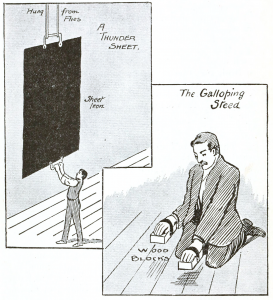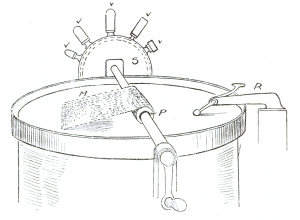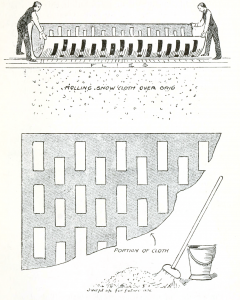Before sound could be reproduced by recorded means, any sound effects needed in the theatre had to be created by mechanical means. The props department was in charge of coming up with the machines and devices to achieve that. In the rare cases that live sound effects are used in a modern performance, it still tends to be props’ responsibility, though with the advent of sound designers, you will always have some cross-departmental collaboration.
The devices used for the most common sounds were fairly standard during the last few centuries. I found some great illustrations of these in a 1900 book entitled Secrets of Scene Painting and Stage Effects by Van Dyke Browne (what a name for a scene painter!)

Thunder was created by hanging a large sheet of thin iron and shaking it. If you’ve ever carried a large sheet of thin sheet metal, you can imagine the sound something as large in the picture can create.
Wood blocks were used to generate the sound of galloping horses; they had elastic bands to keep them on the prop-person’s hands. The book points out that some property masters preferred the use of coconut halves, though this required the cut ends to be perfectly flat and smooth.

The sound of rain was made by filling a long box with small pebbles. The box had a center pivot point which allowed it to tilt; all the pebbles would tumble to the other side. If you’ve ever played with a rain stick, it is the same general idea.
The “wind-producing drum” is a bit of a mystery to me. Browne neglects to describe this drawing, and I cannot be certain of its possible sound or intended use. Most of us are more familiar with the next drawing as a machine to create the sound of wind.

A piece of silk is draped over a drum made of slats of wood with spaces in between. The drum can be turned to create the sound of wind.
The following are more esoteric devices. With the advent of cinema, foley artists (as the creators of mechanical sound effects were called) had to come up with ways to create sound effects in much smaller places; after all, a cinema has far less space backstage than a theatre for plays.

This is a horse trotting machine. It acts like a more automated version of hitting two coconut halves together. A shaft above has a number of “tappets” (C1 and C2) which pushes the top cup away from the bottom cup (Fig 2). When the tappet clears, a spring connecting the two cups pulls them back together, creating the sound. The triangular cutouts in the top cup help make a louder and richer sound. The “foot lever” on the bottom is used to adjust the distance of the cups from the shaft. When it is further away, the tappets do not push the cup as much, creating a softer sound. Thus, it gives the operator some control over the volume of the galloping horses.

This last machine is an attempt to combine a whole bunch of sound-generating devices into one. The back part (S) has a number of pipes, whistles and bells (V), through which compressed air is run. You can trigger each one individually by turning the air on and off. In the middle of a large drum is a thin sheet of stiff metal (M). Using the handle, you can slap it against the drum to simulate artillery fire. Because it is on a roll (P), you can alter the length of the sheet to control the volume of the slap.
A final lever (R) can be used to generate a rolling effect on the drum, which apparently mimicked the sound of automobiles quite successfully.
The final illustration does not have to do with sound, but it was in the same chapter. I recently wrote a post about the variety of ways a props person simulates snow on stage. Though a snow drop itself is not usually a prop department’s responsibility, it is helpful to know how one works, and so I include the illustration below.

Illustrations originally printed in Secrets of Scene Painting and Stage Effects by Van Dyke Browne. 5th ed., 1900, George Routledge and Sons, Limited. You can read the whole book at the Internet Archive.

